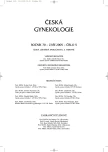Vztah mezi hladinami toxických polychlorovaných bifenylů v krvi a ve folikulární tekutině sterilních žen
Relationship between the Levels of Toxic Polychlorinated Biphenyls in Blood and Follicular Fluid of Sterile Women
Objective:
The aim of this study was to confirm the possibility of detection of toxic polychlorinated biphenyls in blood and follicular fluid of infertile women undergoing IVF+ET program and determine the levels of some congeners. To confirm their cumulation in follicular fluid.
Design:
Pilot study.
Setting:
Department of Obstetrics and Gynecology, 1st Faculty of Medicine, Charles University and General Faculty Hospital, Prague, AXYS Varilab s.r.o., Vrané nad Vltavou, Institute of Hygieny and Epidemiology, 1st Faculty of Medicine Charles University and General Faculty Hospital, Prague, Euromise Centrum, Charles University, Prague.
Methods:
We detected the level of polychlorinated biphenyls in blood and follicular fluid of infertile women undergoing IVF+ET program. We recieved the follicular fluid by transvaginal punction of follicles under ultrasonography control. The blood was taken before begining of anestezia. The follicular fluid and blood were frozen and transported to the laboratory. The samples were examined there by methods of gas chromatography and mass spectrometry. We were able to find all PCBs with 3–7 atoms of chlorine.
Results:
We confirmed the possibility of detection of polychlorinated biphenyls (PCBs) in blood and follicular fluid of infertile women. We examineted the levels of PCB 77, 81, 105, 114, 118+123, 126, 156, 157, 167, 169, 189. The levels of PCBs were in ng/gram of fat.
The levels of polychlorinated biphenyls differed from 0 to 400 ng/g of fat. Statistical analysis was made by t test a Wilcox test. All PCBs are cumulated in follicular fluid, except of PCB 126.
Conclusion:
The possibility of detection of PCBs in blood and follicular fluid of infertile women undergoing IVF+ET program was confirmed. The cumulation of these xenobiotics in follicular fluid was found. In the future we will analyse the relationship between the presence of these xenobiotics and achieving succesful pregnancy.
Key words:
IVF+ET program, polychlorinated biphenyls, kongeners, xenobiotics
Autoři:
P. Drbohlav 1; Simona Jirsová 1
; J. Mašata 1; L. Jech 2; V. Bencko 3; M. Omelka 4; J. Zvárová 4
Působiště autorů:
Gynekologicko-porodnická klinika 1. LF UK a VFN, Praha, přednosta prof. MUDr. A. Martan, DrSc.
1; AXYS Varilab s. r. o., Vrané nad Vltavou, vedoucí laboratoře RNDr. L. Jech, CSc.
2; Ústav hygieny a epidemiologie 1. LF UK, Praha, přednosta prof. MUDr. V. Bencko, DrSc.
3; Euromise centrum, Karlova univerzita a Akademie věd, Praha, ředitelka prof. RNDr. J. Zvárová, DrSc.
4
Vyšlo v časopise:
Ceska Gynekol 2005; 70(5): 377-383
Kategorie:
Původní práce
Souhrn
Cíl práce:
Cílem studie bylo prokázat přítomnost toxických polychlorovaných bifenylů v krvi a ve folikulární tekutině žen zařazených do programu IVF+ET a určit hladiny jednotlivých kongenerů. Prokázat, zda se toxické bifenyly nekumulují ve folikulární tekutině.
Typ studie:
Pilotní studie.
Název a sídlo pracoviště:
Gynekologicko-porodnická klinika 1. LF a VFN, Praha, AXYS Varilab s.r.o.,
Vrané nad Vltavou, Ústav hygieny a epidemiologie 1. LF UK, Praha, Euromise Centrum, Karlova Univerzita a Akademie věd, Praha.
Metodika:
Hladiny toxických polychlorovaných bifenylů byly stanoveny v krvi a folikulární tekutině 30 žen zařazených do programu IVF+ET. Folikulární tekutina byla odebrána transvaginálně pod ultrazvukovou kontrolou. Před úvodem do anestezie byl odebrán vzorek venózní krve. Folikulární tekutina a krev byly zamraženy a předány do laboratoře. Vzorky byly zpracovány metodou vysokorozlišující hmotnostní spektrometrie a plynové chromatografie. Analytická metoda zachycovala všechny existující kongenery PCB s 3 až 7 atomy chloru.
Výsledky:
Vyšetřeny byly hladiny PCB 77, 81, 105, 114, 118+123, 126, 156, 157, 167, 169, 189. Hladiny toxických bifenylů byly stanoveny v ng na gram tuku navážky. Hladiny se pohybovaly od nedetekovatelných hladin až do 400 ng/g tuku navážky. Statistické vyhodnocení bylo provedeno t testem a Wilcoxonovým testem. Všechny bifenyly (kromě PCB 126) jsou více zastoupeny ve folikulární tekutině.
Závěr:
PCB jsou přítomny v krvi i ve folikulární tekutině neplodných pacientek zařazených do programu IVF+ET. Většina stanovovaných xenobiotik se kumuluje ve folikulární tekutině. V dalším sledování bude analyzován vliv těchto látek na úspěšnost programu IVF+ET.
Klíčová slova:
IVF+ET, polychlorované bifenyly, kongenery, xenobiotika
Štítky
Dětská gynekologie Gynekologie a porodnictví Reprodukční medicínaČlánek vyšel v časopise
Česká gynekologie

2005 Číslo 5
Nejčtenější v tomto čísle
- Délka hráze a porodní poranění
- Embolizace děložních tepen při léčbě myomů z pohledu pacientek
- Antifungální účinek u vybraných přírodních látek a probiotik, jejich možnosti použití v profylaxi vulvovaginitidy
- Ovlivňuje počet získaných oocytů při ovariální punkci následnou morfologickou kvalitu embryí?
